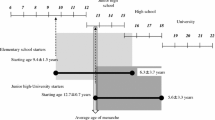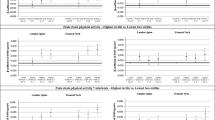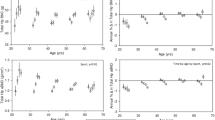Abstract
The major effect of weightbearing exercise on adult bone mass may be exerted during childhood. We examined the relationship between reported hours of ballet classes per week undertaken as a child and adult bone mineral density (BMD) at the hip, spine, and forearm. We performed a retrospective cohort study in 99 female retired dancers (mean age 51 years, SD 14 years) and 99 normal controls, derived from a twin study, matched hierarchically for age, height, weight and menopausal status. Starting age of ballet was recalled and weekly hours of ballet as a child was self-reported on two occasions. BMD was measured using dual-energy X-ray absorptiometry and reported as a Z-score. Self-reported hours of ballet class undertaken per week at each age between 10 and 12 years was positively associated with a difference in BMD between dancers and controls at both the femoral neck site (β=0.73,p=0.001) and the total hip site (β=0.55,p <0.01). These associations were unaffected by adjustment for covariates including measures of adult activity (current physical activity, years of fulltime ballet), measures of menstrual disturbance (age of menarche, history of irregular menses), dietary history (calcium intake as a child, adolescent or adult) or lifestyle factors (lifetime smoking, lifetime alcohol). Although starting age of ballet was negatively associated with weight-adjusted within-pair hip BMD difference, it was no longer associated after adjustment for weekly hours of ballet. There was no relationship between hours of ballet undertaken as a child and differences in BMD at the lumbar spine or upper limb, at any age. Our data suggest that classical ballet classes undertaken between the ages of 10 and 12 years are independently and positively associated with a difference in hip BMD between dancers and controls. The findings are consistent with the hypothesis that this age range identifies a stage of development when the proximal femur is particularly responsive to weightbearing exercise.
Similar content being viewed by others
References
Cummings SR, Black DM, Nevitt MC, et al. Bone density at various sites for prediction of hip fractures. Lancet 1993;341:72–5.
Melton LJ, Atkinson EJ, O’Fallon WM, Wahner HZ, Riggs BL. Long-term fracture prediction by bone mineral assessed at different skeletal sites. J Bone Miner Res 1993;8:1227–33.
Cummings SR, Rubin SM, Black D. The future of hip fractures in the United States. Clin Orthop 1990;252:163–6.
Wark JD. Osteoporosis: the emerging epidemic [editorial]. Med J Aust 1996;164:327–8.
Consensus Development Conference. Diagnosis, prophylaxis and treatment of osteoporosis. Am J Med 1993;94:646–50.
Garn SM, Wagner B. The adolescent growth of the skeletal mass and its implications to mineral requirements. In: Heald FP, editor. Adolescent nutrition and growth. New York: Appleton-Century-Crofts, 1969:139–61.
Mazess RB, Cameron JR. Skeletal growth in school children: maturation and bone mass. Am J Phys Anthropol 1971;35:399–408.
Seeman E, Wahner HW, Offord KP, et al. The differential effects of endocrine dysfunction on the axial and appendicular skeleton. J Clin Invest 1982;69:1302–9.
Gortmaker SL, Must A, Sobol AM, Peterson K, Colditz G, Kietz WH. Television viewing as a cause of increasing obesity among children in the United States, 1986–1990. Arch Pediatr Adolesc Med 1996;150:356–62.
Office of Disease Prevention and Health Promotion: summary of findings from National Children and Youth Fitness Survey. Washington, DC: US Department of Health and Human Services USPHS, USA, 1984.
Bailey DA, Faulkner RA, McKay HA. Growth, physical activity, and bone mineral acquisition. In: Holloszy JO, editor. Exercise and sport sciences reviews vol 24. Baltimore: Williams & Wilkins, 1996:233–66.
Slemenda CW, Reister TK, Hui SL, Miller JZ, Christian JC, Johnston CC. Influences on skeletal mineralization in children and adolescents: evidence for varying effects of sexual maturation and physical activity. J Pediatr 1994;125:201–7.
Bailey DA. The Saskatchewan bone mineral accrual study: bone mineral acquisition during the growing years. Int J Sports Med 1997;18(Suppl 3):S191–4.
Bonjour J-P, Theintz G, Buchs B, Slosman D, Rizzoli R. Critical years and stages of puberty for spinal and femoral bone mass accumulation during adolescence. J Clin Endocrinol Metab 1991;73:555–63.
Kriska AM, Sandler RB, Cauley J, Laporte RE, Hom DL, Pambianco G. The assessment of historical physical activity and its relation to adult bone parameters. Am J Epidemiol 1988;127:1053–61.
Schantz PG, Astrand P-O. Physiological characteristics of classical ballet. Med Sci Sports Exerc 1984;16:472–6.
Khan K, Brown J, Way S, etal. Overuse injuries in classical ballet. Sports Med 1995;19:341–57.
Grant G. Technical manual and directory of classical ballet. New York: Dover, 1982.
Hamilton WG. Ballet. In: Reider B, editor. Sports medicine. The school-age athlete. Philadelphia: WB Saunders, 1991: 484–519.
Hamilton LH, Hamilton WG, Meltzer JD, Marshall P, Molnar M. Personality, stress, and injuries in professional ballet dancers. Am J Sports Med 1989;17:263–7.
Cross V, Bolvin C. Bone density and injury in ballet dancers. The Dancing Times 1995;1187–9.
Karlsson MK, Johnell O, Obrant KJ. Bone mineral density in professional ballet dancers. Bone Miner 1993;21:163–9.
Warren MP, Brooks-Gunn J, Fox RP, Lancelot C, Newman D, Hamilton WG. Lack of bone accretion and amenorrhea: evidence for a relative osteopenia in weightbearing bones. J Clin Endocrinol Metab 1991;72:847–53.
Young N, Formica C, Szmukler G, Seeman E. Bone density at weight-bearing and non-weight-bearing sites in ballet dancers: the effects of exercise, hypogonadism and body weight. J Clin Endocrinol Metab 1994;78:449–54.
Van Marken Lichtenbelt WD, Fogelholm M, Ottenheijm R, Westerterp KR. Physical activity, body composition, and bone density in ballet dancers. Br J Nutr 1995;74:439–51.
Jonnavithula S, Warren MP, Fox RP, Lazaro MI. Bone density is compromised in amenorrheic women despite return of menses: a 2-year study. Obstet Gynecol 1993;81:669–74.
Keay N, Fogelman I, Blake G. Bone mineral density in professional female dancers. Br J Sports Med 1997;31:143–7.
Khan KM, Green R, Saul A, et al. Retired elite female ballet dancers have similar bone mineral density at weightbearing sites to nonathletic controls. J Bone Miner Res 1996;11:1566–1574.
Flicker L, Hopper JL, Rodgers L, Kaymakci B, Green RM, Wark JD. Bone density determinants in elderly women: a twin study. J Bone Miner Res 1995;10:1607–13.
Young D, Hopper JL, Nowson CA, et al. Determinants of bone mass in 10- to 26-year-old females: a twin study. J Bone Miner Res 1995;10:558–67.
Flicker L, Faulkner KG, Hopper JL, et al. Determinants of hip axis length in women aged 10 to 89 years: a twin study. Bone 1996;18:34–41.
Shrout PE, Fleiss JL. Intraclass correlations: uses in assessing rater reliability. Psychol Bull 1979;86:420–8.
Khan KM, Henzell SL, Prince RL, et al. Instrument performance in bone density testing at five Australian centres. Aust NZ J Med 1997;27:526–30.
Flicker L, Green R, Kaymakci B, Lichtenstein M, Buirski G, Wark JD. Do Australian women have greater spinal bone density than North American women? Osteoporos Int 1995;5:63–5.
Kirkwood BR. Essentials of medical statistics. Oxford: Blackwell Scientific, 1988.
Hopper JL, Seeman E. The bone density of female twins discordant for tobacco use. N Engl J Med 1994;330:387–92.
Gardner MJ, Altman DG, editor. Statistics with confidence: confidence intervals and statistical guidelines. London: BMJ Publications, 1989: 90.
Khan KM, Bennell KL, Green RM, et al. Ballet classes undertaken at age 11 predict augmented hip bone mineral density an average of 40 years later. J Bone Miner Res 1996;11(Suppl):S103.
Kannus P, Haaspasalo H, Sankelo M, et al. Effect of starting age of physical activity on bone mass in the dominant arm of tennis and squash players. Ann Intern Med 1995;123:27–31.
Mauras N, Rogol AD, Veldhuis JD. Specific, time-dependent actions of low-dose ethinyl estradiol administration on the episodic release of GH, FSH and LH in prepubertal girls with Turner’s syndrome. J Clin Endocrinol Metab 1989;69:1053–8.
Malina RM, Bouchard C. Growth, maturation, and physical activity. Champaign, IL: Human Kinetics, 1991:501.
Myburgh KH, Bachrach LK, Lewis B, Kent K, Marcus R. Low bone mineral density in axial and appendicular sites in amenorrheic athletes. Med Sci Sports Exerc 1993;25:1197–202.
Morris FL, Naughton GA, Gibbs JL, Carlson JS, Wark JD. Prospective 10-month exercise intervention in premenarcheal girls: positive effect on bone and lean mass. J Bone Miner Res 1997;12:1453–62.
Slemenda CW, Johnston CC. High intensity activities in young women: site specific bone mass effects among female figure skaters. Bone Miner 1993;20:125–32.
Fehling PC, Alekel L, Clasey J, Rector A, Stillman RJ. A comparison of bone mineral densities among female athletes in impact loading and active loading sports. Bone 1995;17:205–10.
Bennell KL, Malcolm SA, Khan KM, et al. Bone mass and bone turnover in power athletes, endurance athletes and controls: a 12 month longitudinal study. Bone 1997;20:477–84.
Frost HM. Why do marathon runners have less bone than weight-lifters? A vital-biomechanical view and explanation. Bone 1997;20:183–9.
Bennell KL, Skeletal effects of menstrual disturbances in athletes. Scand J Med Sci Sports 1997 (in press).
Welten DC, Kemper HCG, Post GB, et al. Weight-bearing activity during youth is a more important factor for peak bone mass than calcium intake. J Bone Miner Res 1994;9:1089–96.
Rubin CT. Skeletal strain and the functional significance of bone architecture. Calcif Tissue Int 1984;36:S11–8.
Frost HM. The role of changes in mechanical usage set points in the pathogenesis of osteoporosis. J Bone Miner Res 1992;7:253–61.
Rubin CT, Lanyon LE, Osteoregulatory nature of mechanical stimuli: function as a determinant for adaptive remodeling in bone. J Orthop Res 1987;5:300–10.
Forwood MR, Burr DB. Physical activity and bone mass: exercises in futility? Bone Miner 1993;21:89–112.
Lanyon LE. Control of bone architecture by functional load bearing. J Bone Miner Res 1992;7:S369–75.
Rencken ML, Chesnut CH III, Drinkwater BL. Brief report. Bone density at multiple skeletal sites in amenorrheic athletes. JAMA 1996;276:238–40.
Wennink JMB, Delemarre-van de Waal HA, Schoemaker R, Blaauw G, van den Braken C, Schoemaker J. Growth hormone secretion patterns in relation to LH and estradiol secretion throughout normal female puberty. Acta Endocrinol (Copenh) 1991;124:129–35.
Finkelstein JW, Roffwarg HP, Boyar RM, Kream J, Hellman L. Age-related change in the twenty-four-hour spontaneous secretion of growth hormone. J Clin Endocrinol Metab 1972;35:665–70.
Zadik Z, Chalew SA, McCarter RJ, Meistas M, Kowarski KA. The influence of age on the 24-hour integrated concentration of growth hormone in normal individuals. J Clin Endocrinol Metab 1985;60:513–6.
Kannus P, Sievanen H, Vuori I. Physical loading and bone. Bone 1996;18:1S-3S.
Dunger DB, Matthews DR, Edge JA, Jones J, Preece MA. Evidence for temporal coupling of growth hormone, prolactin, LH and FSH pulsatility overweight during normal puberty. J Endocrinol 1991;130:141–9.
Mauras N, Rogol AD, Haymond MW, Veldhuis JD. Sex steroids, growth hormone, insulin-like growth factor-1: neuroendocrine and metabolic regulation in puberty. Hormone Res 1996;45:74–80.
McCarthy TL, Centrella M, Canalis E. Insulin-like growth factor and bone. Connect Tissue Res 1989;20:277–82.
Brown JB, Harrison P, Smith MA. Oestrogen and pregnanediol excretion throughout childhood, menarche and first ovulation. J Biosocial Sci Suppl 1978;5:43–62.
Blumsholm A, Hannon RA, Wrate R. Biochemical markers of bone turnover in girls during puberty. Clin Endocrinol 1994;40:663–70.
Author information
Authors and Affiliations
Corresponding author
Rights and permissions
About this article
Cite this article
Khan, K.M., Bennell, K.L., Hopper, J.L. et al. Self-reported ballet classes undertaken at age 10–12 years and hip bone mineral density in later life. Osteoporosis Int 8, 165–173 (1998). https://doi.org/10.1007/BF02672514
Received:
Accepted:
Issue Date:
DOI: https://doi.org/10.1007/BF02672514




